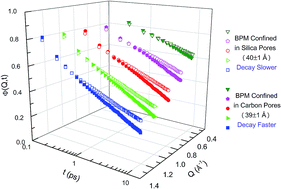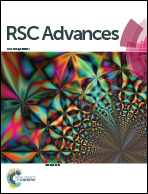Higher-order glass-transition singularities in nano-confined states†
Abstract
The dynamic processes of 2-biphenylmethanol (BPM) confined in carbon and silica pores with different sizes have been studied using the quasi-elastic neutron scattering (QENS) technique. A β-relaxation process following a logarithmic decay was found in both the nano-confined states. The peculiar features of the observed dynamic processes strongly agree with the predictions of the mode-coupling theory (MCT) for higher-order glass-transition singularities. The MCT critical temperature (Tc) of BPM, when confined in carbon and silica pores, was evaluated. The Tc was significantly low in the nano-confined states as compared to the bulk states. Furthermore, when comparing BPM confined in similar pore-sized carbon and silica materials, it was observed that the Tc was much lower for BPM confined in nano-porous silica materials. The generalized vibrational density-of-states of confined BPM indicated that the interactions of BPM with the silica pores is hydrophobic, whereas the interactions with the carbon surfaces is more hydrophilic. The different lowering of Tc for BPM depending on whether it is confined in carbon or silica materials is due to the different nature of the interactions between BPM and the confining surfaces of silica and carbon.



 Please wait while we load your content...
Please wait while we load your content...